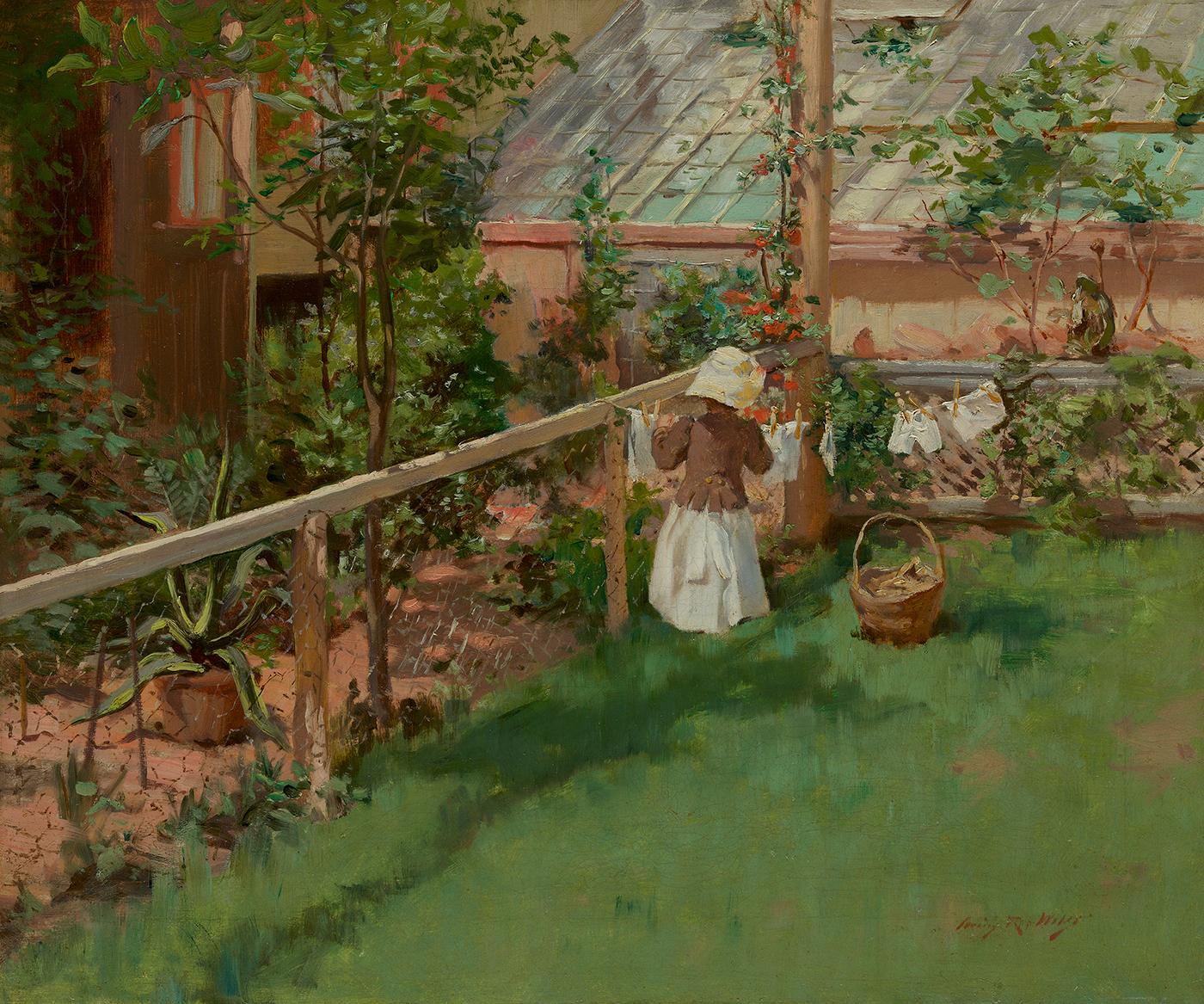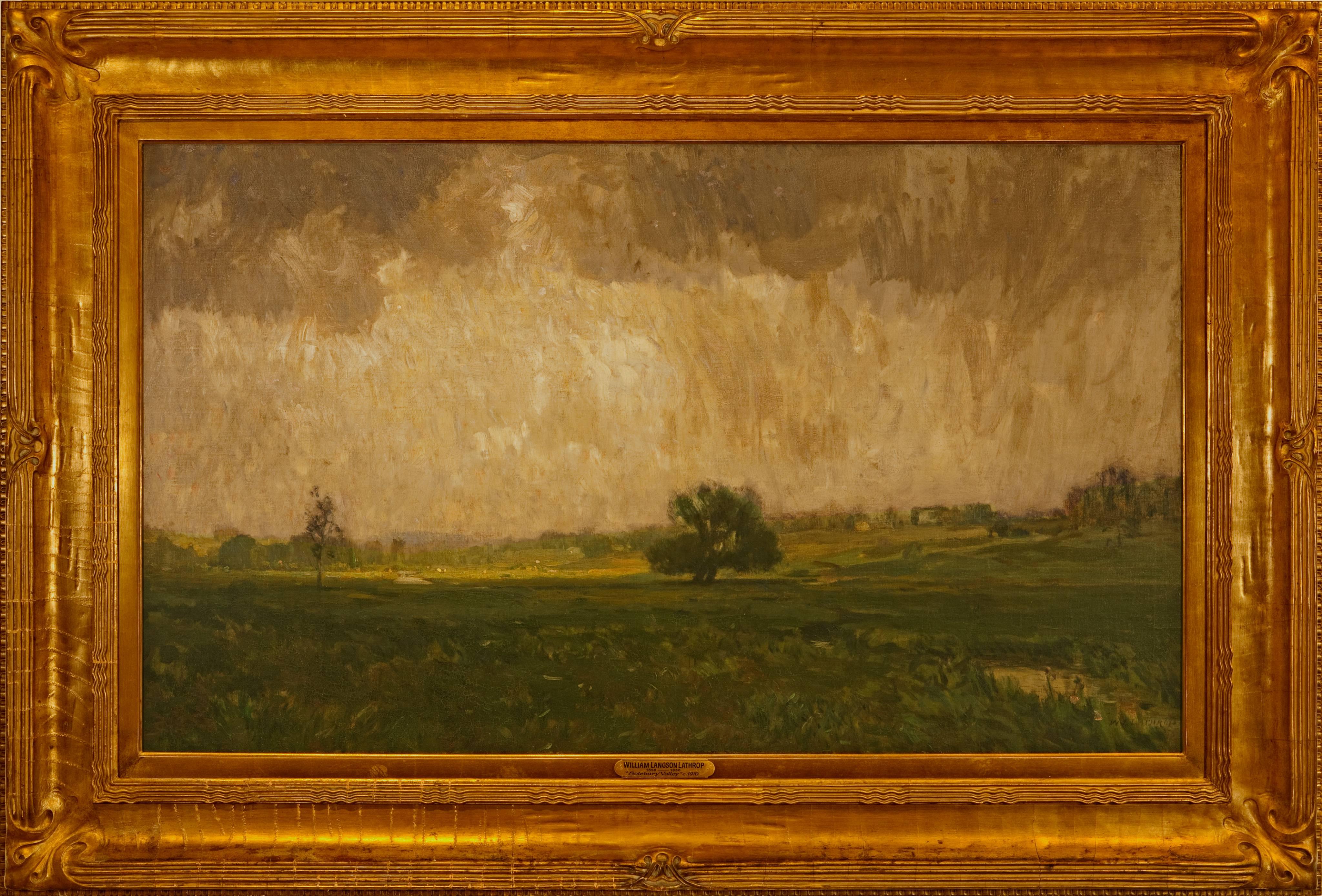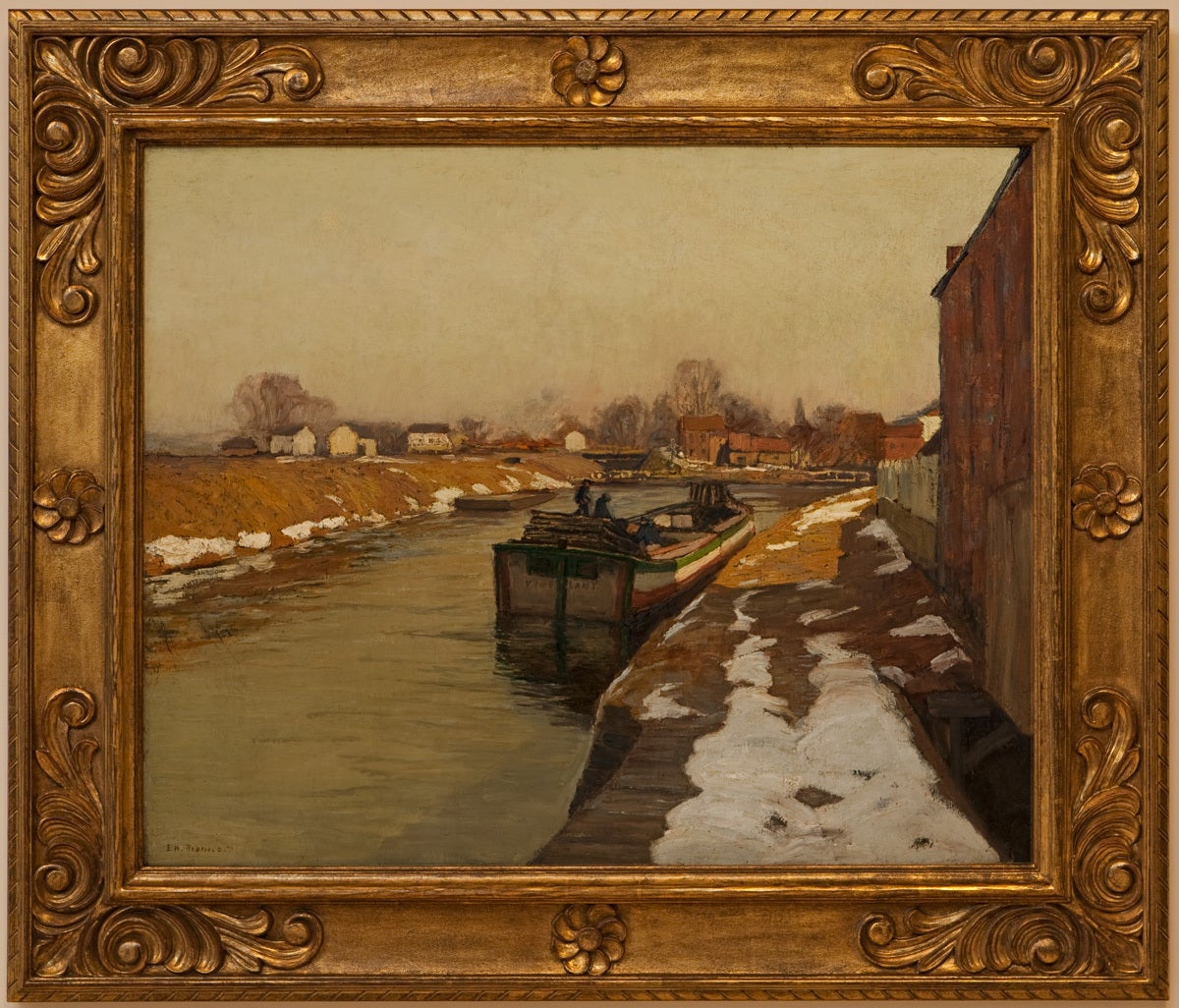Robert William WoodSunset in the Sierra's 1942 - California Mountain Landscape oil on canvas framed1942
1942
About the Item
- Creator:Robert William Wood (1889-1979, American)
- Creation Year:1942
- Dimensions:Height: 28 in (71.12 cm)Width: 36 in (91.44 cm)
- Medium:
- Movement & Style:
- Period:
- Condition:In excellent, age appropriate condition.
- Gallery Location:Rancho Santa Fe, CA
- Reference Number:1stDibs: LU516312883792
Robert William Wood
Robert William Wood (1889–1979) is often considered to be among America’s most prolific artists because of the extraordinary number of landscapes he painted of the country’s greatest natural treasures — scenes as diverse as the California coast, the Rocky Mountains and springtime in the Texas bluebonnets. The gifted painter worked for nearly 60 years, often completing one painting a day.
Today, Robert Wood paintings are very popular for those seeking to bring luminous landscapes into their homes.
Wood was born in Kent, England, and emigrated in 1910 to the United States, where he spent his whole career. He was fond of plein air painting, which refers to the practice of painting outdoors, and when Wood moved to California from Texas in 1941, the last of the painters associated with the California Plein-Air School were still exhibiting but the popularity of the movement was dwindling. Wood’s paintings contain a great deal of detail and delicacy, but toward the end of his career in the mid-1950s, the artist began painting in a more Impressionistic style, with looser, bolder brushstrokes.
The critically acclaimed art movements that arose during Wood’s lifetime — Abstract Expressionism and Pop art among them — were far removed from the kind of traditional art that Wood practiced, and he did not seek to promote himself. But despite the artist’s lack of critical success, Wood was immensely popular and became a household name. Millions of color reproductions of his paintings, which have been praised for their depictions of natural light and enchanting use of color, have been sold over the years and can be found in homes all over the United States.
Find Robert Wood paintings on 1stDibs.
- ShippingRetrieving quote...Ships From: Cleveland, OH
- Return PolicyThis item cannot be returned.
- Wild Flowers Verbena in High Desert Palm Springs CA Pink & White Snowy MountainsLocated in Rancho Santa Fe, CAA very lovey Impressionist painting depicting spring wildflowers in the desert near Palm Springs, California. In a classic, carved, gold leaf frame. Frame dimensions are 30 x 40 inch...Category
Mid-20th Century American Impressionist Landscape Paintings
MaterialsOil, Cotton Canvas
- Cabin amongst Eucalyptus Trees, Old Laguna Beach Landscape, California 1930s o/cBy Andrew LundLocated in Rancho Santa Fe, CAA lovely landscape painting from the 1930s of a cabin amongst the eucalyptus trees in Old Laguna Beach, California. Oil on canvas Signed lower left Dimensions: 30 x 36 inches Framed...Category
Early 20th Century American Impressionist Landscape Paintings
MaterialsCanvas, Oil
- Tall Ships in the HarborBy Paul Bernard KingLocated in Rancho Santa Fe, CAAmerican painter Paul King was born in Buffalo, New York on February 9, 1867. Mounted in a carved, gold leaf frame. This painting ships from San Diego, CA.Category
Early 20th Century American Impressionist Landscape Paintings
MaterialsOil, Masonite
- Sailing Boats in Harbor (Possibly Mohnegan Island, Maine)By Paul Bernard KingLocated in Rancho Santa Fe, CAMounted in a period, hand carved, gold leaf frame. Signed lower right "Paul King"Category
Early 20th Century American Impressionist Landscape Paintings
MaterialsOil, Masonite
- California Landscape with Hay Shocks - 1940s Oil/Board - Trees & MountainsLocated in Rancho Santa Fe, CAAn oil painting on board by Irving Manoir depicting a California landscape with hay shocks circa the 1940s. Irving Kraut Manoir earned a reputation as painter and art teacher, and ...Category
Mid-20th Century American Impressionist Landscape Paintings
MaterialsOil, Board
- Sailboats Docked - Saint-Mandrier, Toulon, FranceBy Georges Jules Ernest BinetLocated in Rancho Santa Fe, CABorn in Le Havre in 1865, Binet painted both in Paris and in Normandy, capturing scenes of modern, everyday life. A pupil of Francois Cormon and Raphael Collin, he is known for his n...Category
Early 20th Century Impressionist Landscape Paintings
MaterialsCanvas, Oil
- At the ClotheslineBy Irving Ramsey WilesLocated in New York, NYSigned lower right: Irving R. WilesCategory
Late 19th Century American Impressionist Landscape Paintings
MaterialsCanvas, Oil
- "Alley Fiends"By John R. GrabachLocated in Lambertville, NJJim’s of Lambertville is proud to offer this artwork by: John R. Grabach (1886 - 1981) John Grabach was a highly regarded New Jersey artist, teacher, and author of the classic text...Category
1930s American Impressionist Landscape Paintings
MaterialsCanvas, Oil
- "Forest Strongholds"By John F. CarlsonLocated in Lambertville, NJSigned lower right. Complemented by a hand carved and gilt frame. Exhibited at the National Academy of Design, 1928Category
20th Century American Impressionist Landscape Paintings
MaterialsCanvas, Oil
- "Solebury Valley"By William Langson LathropLocated in Lambertville, NJSigned lower right. Complemented by a period frame. William L. Lathrop (1859-1938) Deemed “Father of the New Hope Art Colony”, William Langson Lathrop was born in Warren, Illinois. He was largely self-taught, having only studied briefly with William Merritt Chase in 1887, at the Art Students League. Lathrop first moved east in the early 1880s, and took a job at the Photoengraving Company in New York City. While there, he befriended a fellow employee, Henry B. Snell. The two men became lifelong friends and ultimately, both would be considered central figures among the New Hope Art Colony. Lathrop's early years as an artist were ones of continuing struggle. His efforts to break through in the New York art scene seemed futile, so he scraped enough money together to travel to Europe with Henry Snell in1888. There he met and married an English girl, Annie Burt. Upon returning to New York, he tried his hand at etching, making tools from old saw blades...Category
1910s American Impressionist Landscape Paintings
MaterialsCanvas, Oil
- Winter MoonlightBy George William SotterLocated in Lambertville, NJsigned lower rightCategory
1910s American Impressionist Landscape Paintings
MaterialsCanvas, Oil
- "The Canal"By Edward Willis RedfieldLocated in Lambertville, NJJim’s of Lambertville is proud to offer this artwork. Signed lower left. Complemented by a hand carved and gilt frame. Illustrated in "Edward Redfield: Just Values and Fine Seeing" by Constance Kimmerle and the Pennsylvania Academy of the Fine Arts's Exhibition of Paintings by Edward Redfield (April 17 to May 16, 1909) brochure Edward Willis Redfield (1869 - 1965) Edward W. Redfield was born in Bridgeville, Delaware, moving to Philadelphia as a young child. Determined to be an artist from an early age, he studied at the Spring Garden Institute and the Franklin Institute before entering the Pennsylvania Academy from 1887 to 1889, where he studied under Thomas Anshutz, James Kelly, and Thomas Hovenden. Along with his friend and fellow artist, Robert Henri, he traveled abroad in 1889 and studied at the Academie Julian in Paris under William Bouguereau and Tony Robert-Fleury. While in France, Redfield met Elise Deligant, the daughter of an innkeeper, and married in London in 1893. Upon his return to the United States, Redfield and his wife settled in Glenside, Pennsylvania. He remained there until 1898, at which time he moved his family to Center Bridge, a town several miles north of New Hope along the Delaware River. Redfield painted prolifically in the 1890s but it was not until the beginning of the twentieth century that he would develop the bold impressionist style that defined his career. As Redfield’s international reputation spread, many young artists gravitated to New Hope as he was a great inspiration and an iconic role model. Edward Redfield remained in Center Bridge throughout his long life, fathering his six children there. Around 1905 and 1906, Redfield’s style was coming into its own, employing thick vigorous brush strokes tightly woven and layered with a multitude of colors. These large plein-air canvases define the essence of Pennsylvania Impressionism. By 1907, Redfield had perfected his craft and, from this point forward, was creating some of his finest work. Redfield would once again return to France where he painted a small but important body of work between 1907 and 1908. While there, he received an Honorable Mention from the Paris Salon for one of these canvases. In 1910 he was awarded a Gold Medal at the prestigious Buenos Aires Exposition and at the Panama-Pacific Exposition of 1915 in San Francisco, an entire gallery was dedicated for twenty-one of his paintings. Since Redfield painted for Exhibition with the intent to win medals, his best effort often went into his larger paintings. Although he also painted many fine smaller pictures, virtually all of his works were of major award-winning canvas sizes of 38x50 or 50x56 inches. If one were to assign a period of Redfield’s work that was representative of his “best period”, it would have to be from 1907 to 1925. Although he was capable of creating masterpieces though the late 1940s, his style fully matured by 1907 and most work from then through the early twenties was of consistently high quality. In the later 1920s and through the 1930s and 1940s, he was like most other great artists, creating some paintings that were superb examples and others that were of more ordinary quality. Redfield earned an international reputation at a young age, known for accurately recording nature with his canvases and painting virtually all of his work outdoors; Redfield was one of a rare breed. He was regarded as the pioneer of impressionist winter landscape painting in America, having few if any equals. Redfield spent summers in Maine, first at Boothbay Harbor and beginning in the 1920s, on Monhegan Island. There he painted colorful marine and coastal scenes as well as the island’s landscape and fishing shacks. He remained active painting and making Windsor style furniture...Category
Early 1900s American Impressionist Landscape Paintings
MaterialsCanvas, Oil






